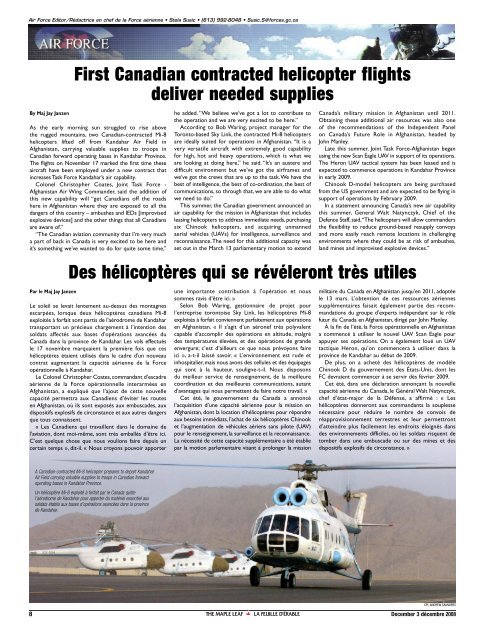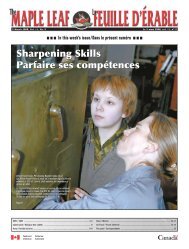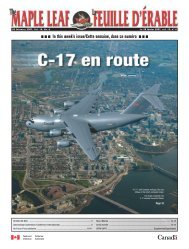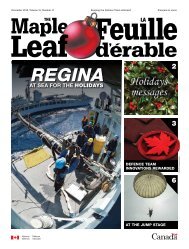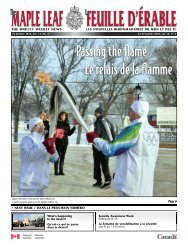Télécharger l'édition complète (version PDF, 2792k)
Télécharger l'édition complète (version PDF, 2792k)
Télécharger l'édition complète (version PDF, 2792k)
You also want an ePaper? Increase the reach of your titles
YUMPU automatically turns print PDFs into web optimized ePapers that Google loves.
Air Force Editor/Rédactrice en chef de la Force aérienne • Stela Susic • (613) 992-8048 • Susic.S@forces.gc.ca<br />
By Maj Jay Janzen<br />
8<br />
First Canadian contracted helicopter flights<br />
deliver needed supplies<br />
As the early morning sun struggled to rise above<br />
the rugged mountains, two Canadian-contracted Mi-8<br />
helicopters lifted off from Kandahar Air Field in<br />
Afghanistan, carrying valuable supplies to troops in<br />
Canadian forward operating bases in Kandahar Province.<br />
The flights on November 17 marked the first time these<br />
aircraft have been employed under a new contract that<br />
increases Task Force Kandahar’s air capability.<br />
Colonel Christopher Coates, Joint Task Force -<br />
Afghanistan Air Wing Commander, said the addition of<br />
this new capability will “get Canadians off the roads<br />
here in Afghanistan where they are exposed to all the<br />
dangers of this country – ambushes and IEDs [improvised<br />
explosive devices] and the other things that all Canadians<br />
are aware of.”<br />
“The Canadian aviation community that I’m very much<br />
a part of back in Canada is very excited to be here and<br />
it’s something we’ve wanted to do for quite some time,”<br />
Par le Maj Jay Janzen<br />
he added. “We believe we’ve got a lot to contribute to<br />
the operation and we are very excited to be here.”<br />
According to Bob Waring, project manager for the<br />
Toronto-based Sky Link, the contracted Mi-8 helicopters<br />
are ideally suited for operations in Afghanistan. “It is a<br />
very versatile aircraft with extremely good capability<br />
for high, hot and heavy operations, which is what we<br />
are looking at doing here,” he said. “It’s an austere and<br />
difficult environment but we’ve got the airframes and<br />
we’ve got the crews that are up to the task. We have the<br />
best of intelligence, the best of co-ordination, the best of<br />
communications, so through that, we are able to do what<br />
we need to do.”<br />
This summer, the Canadian government announced an<br />
air capability for the mission in Afghanistan that includes<br />
leasing helicopters to address immediate needs, purchasing<br />
six Chinook helicopters, and acquiring unmanned<br />
aerial vehicles (UAVs) for intelligence, surveillance and<br />
reconnaissance. The need for this additional capacity was<br />
set out in the March 13 parliamentary motion to extend<br />
Des hélicoptères qui se révéleront très utiles<br />
Le soleil se levait lentement au-dessus des montagnes<br />
escarpées, lorsque deux hélicoptères canadiens Mi-8<br />
exploités à forfait sont partis de l'aérodrome de Kandahar<br />
transportant un précieux chargement à l’intention des<br />
soldats affectés aux bases d'opérations avancées du<br />
Canada dans la province de Kandahar. Les vols effectués<br />
le 17 novembre marquaient la première fois que ces<br />
hélicoptères étaient utilisés dans le cadre d'un nouveau<br />
contrat augmentant la capacité aérienne de la Force<br />
opérationnelle à Kandahar.<br />
Le Colonel Christopher Coates, commandant d’escadre<br />
aérienne de la Force opérationnelle interarmées en<br />
Afghanistan, a expliqué que l'ajout de cette nouvelle<br />
capacité permettra aux Canadiens d’éviter les routes<br />
en Afghanistan, où ils sont exposés aux embuscades, aux<br />
dispositifs explosifs de circonstance et aux autres dangers<br />
que tous connaissent.<br />
« Les Canadiens qui travaillent dans le domaine de<br />
l’aviation, dont moi-même, sont très emballés d’être ici.<br />
C’est quelque chose que nous voulions faire depuis un<br />
certain temps », dit-il. « Nous croyons pouvoir apporter<br />
A Canadian-contracted Mi-8 helicopter prepares to depart Kandahar<br />
Air Field carrying valuable supplies to troops in Canadian forward<br />
operating bases in Kandahar Province.<br />
Un hélicoptère Mi-8 exploité à forfait par le Canada quitte<br />
l’aérodrome de Kandahar pour apporter du matériel essentiel aux<br />
soldats établis aux bases d’opérations avancées dans la province<br />
de Kandahar.<br />
une importante contribution à l’opération et nous<br />
sommes ravis d’être ici. »<br />
Selon Bob Waring, gestionnaire de projet pour<br />
l’entreprise torontoise Sky Link, les hélicoptères Mi-8<br />
exploités à forfait conviennent parfaitement aux opérations<br />
en Afghanistan. « Il s’agit d’un aéronef très polyvalent<br />
capable d’accomplir des opérations en altitude, malgré<br />
des températures élevées, et des opérations de grande<br />
envergure; c’est d’ailleurs ce que nous prévoyons faire<br />
ici », a-t-il laissé savoir. « L’environnement est rude et<br />
inhospitalier, mais nous avons des cellules et des équipages<br />
qui sont à la hauteur, souligne-t-il. Nous disposons<br />
du meilleur service de renseignement, de la meilleure<br />
coordination et des meilleures communications, autant<br />
d’avantages qui nous permettent de faire notre travail. »<br />
Cet été, le gouvernement du Canada a annoncé<br />
l’acquisition d’une capacité aérienne pour la mission en<br />
Afghanistan, dont la location d’hélicoptères pour répondre<br />
aux besoins immédiats, l’achat de six hélicoptères Chinook<br />
et l’augmentation de véhicules aériens sans pilote (UAV)<br />
pour le renseignement, la surveillance et la reconnaissance.<br />
La nécessité de cette capacité supplémentaire a été établie<br />
par la motion parlementaire visant à prolonger la mission<br />
Canada’s military mission in Afghanistan until 2011.<br />
Obtaining these additional air resources was also one<br />
of the recommendations of the Independent Panel<br />
on Canada’s Future Role in Afghanistan, headed by<br />
John Manley.<br />
Late this summer, Joint Task Force-Afghanistan began<br />
using the new Scan Eagle UAV in support of its operations.<br />
The Heron UAV tactical system has been leased and is<br />
expected to commence operations in Kandahar Province<br />
in early 2009.<br />
Chinook D-model helicopters are being purchased<br />
from the US government and are expected to be flying in<br />
support of operations by February 2009.<br />
In a statement announcing Canada’s new air capability<br />
this summer, General Walt Natynczyk, Chief of the<br />
Defence Staff, said, “The helicopters will allow commanders<br />
the flexibility to reduce ground-based resupply convoys<br />
and more easily reach remote locations in challenging<br />
environments where they could be at risk of ambushes,<br />
land mines and improvised explosive devices.”<br />
militaire du Canada en Afghanistan jusqu’en 2011, adoptée<br />
le 13 mars. L’obtention de ces ressources aériennes<br />
supplémentaires faisait également partie des recomman<br />
dations du groupe d’experts indépendant sur le rôle<br />
futur du Canada en Afghanistan, dirigé par John Manley.<br />
À la fin de l’été, la Force opérationnelle en Afghanistan<br />
a commencé à utiliser le nouvel UAV Scan Eagle pour<br />
appuyer ses opérations. On a également loué un UAV<br />
tactique Heron, qu’on commencera à utiliser dans la<br />
province de Kandahar au début de 2009.<br />
De plus, on a acheté des hélicoptères de modèle<br />
Chinook D du gouvernement des États-Unis, dont les<br />
FC devraient commencer à se servir dès février 2009.<br />
Cet été, dans une déclaration annonçant la nouvelle<br />
capacité aérienne du Canada, le Général Walt Natynczyk,<br />
chef d’état-major de la Défense, a affirmé : « Les<br />
hélicoptères donneront aux commandants la souplesse<br />
nécessaire pour réduire le nombre de convois de<br />
réapprovisionnement terrestres et leur permettront<br />
d’atteindre plus facilement les endroits éloignés dans<br />
des environnements difficiles, où les soldats risquent de<br />
tomber dans une embuscade ou sur des mines et des<br />
dispositifs explosifs de circonstance. »<br />
CPL ANDREW SAUNDERS<br />
December 3 décembre 2008


